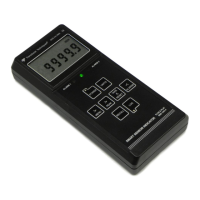5. Noise Filtering
Since electrical noise is often a factor with millivolt signals, the SSI offers programmable
features so that a user can make the best compromise between noise rejection and meter
response rate for the application and noise environment. Note: Noise filtering is only
available at Normal conversion rates of 60 or 50 Hz.
The first selection under the SEtuP menu item is for 60 or 50 Hz noise environments. This
sets the basic conversion rate of the meter to a full line cycle at 60 or 50 Hz, so as to cancel
out the positive and negative components of AC line noise pickup for any conversion.
A value called “filtered value” is listed under the FiLtr menu item. This value can then be
assigned to the Displayed reading and hence logged reading, to Alarms, and to Peak &
Valley. Choices for the filtered value are the following:
Batch average of 16 conversions. The filtered values are independent of each other
and are updated every 267 ms (60 Hz) or 320 ms (50 Hz).
Moving average filter. The equivalent RC time constants are listed in Section 11, FiLtr,
Digit 5. Regardless of the filter method, the meter display is always updated every 16
conversions (3.75 times/second at 60 Hz, 3.125 times/second at 50 Hz) because this is a
good update rate for the human eye.
Autofilter moving average filter. In this mode, the meter automatically selects the best
moving average time constant for the encountered noise condition.
Adaptive filter operation is always functional with moving average filters. This means that
the filter automatically resets the moving average to the current reading when a significant
step in the signal is encountered. With adaptive filtering, the meter can respond rapidly to
meaningful changes in signal level, while filtering out random noise. Two adaptive filter
thresholds are selectable: Low and High. Low should normally be selected, while High
should be selected if high noise transients are expected.
Zero setting (ZEro menu item) can set the meter reading to zero when the signal level is
below a specified percentage of full scale. This avoids meaningless noise readings when
the reading should be zero.
6. Peak, Valley, First Peak, Fast Peak
With the Normal conversion rate, as set up under the SEtuP menu item, Peak, Valley and
First Peak can be based on the Filtered or Unfiltered value, as selected under the FiLtr
menu. The displayed reading in response to pressing the > PEAK key then can be Peak,
First Peak, Valley, or Peak (1
st
push) and Valley (2
nd
push), as selected under the ConFG
menu. Any combination of the current Reading, Peak/First Peak or Valley can be data
logged to a computer via serial communications along with time and date, as selected under
the SEr_3 menu. However, the displayed reading is the only time and date tagged item
logged to internal memory.
With a Fast conversion rate, as set up under the SEtuP menu, the much faster Fast Peak
and First Peak capture modes apply, and all filtering is disabled. When the 128 x Normal
conversion rate is selected, the meter can capture Fast Peaks as fast as every 130 μs.
Polarity of the Fast Peak is pre-selected to be positive or negative under the ConFG menu.

